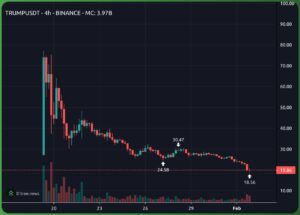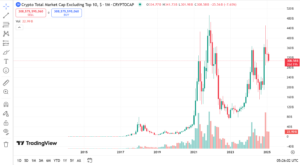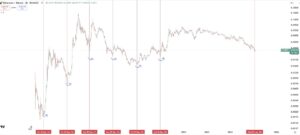Bitcoin’s production cost per unit has historically increased with each halving cycle. This phenomenon highlights the interplay between Bitcoin’s fixed supply mechanism, technological advancements, and economic incentives. Let’s examine the progression of production costs at past halving events, explore the dynamics behind these trends, and predict the potential cost at the 2026 halving.

Understanding Bitcoin Halvings
Bitcoin halving is a pre-programmed event in the Bitcoin network that occurs approximately every four years (or every 210,000 blocks mined). During each halving, the block reward that miners receive for validating transactions and adding them to the blockchain is cut in half. This decreases the rate at which new bitcoins are created, ensuring a controlled supply.
As a result, mining becomes progressively harder and more resource-intensive, often leading to increased production costs per bitcoin. The interplay of energy costs, hardware improvements, and competition drives these increases.
Past Halving Events and Production Costs
2016 Halving
- Block Reward: 25 BTC → 12.5 BTC
- Estimated Production Cost: $1,000 per bitcoin
The 2016 halving marked a shift toward more industrialized mining operations. Larger mining farms and the adoption of energy-efficient ASIC (Application-Specific Integrated Circuit) machines dominated this era, keeping production costs relatively low compared to future cycles.
2020 Halving
- Block Reward: 12.5 BTC → 6.25 BTC
- Estimated Production Cost: $10,000 per bitcoin
By the time of the 2020 halving, Bitcoin mining had become a global, competitive industry. Rising energy costs, increased network difficulty, and advancements in mining hardware significantly raised the production cost to $10,000 per bitcoin.
2024 Halving (Forecasted)
- Block Reward: 6.25 BTC → 3.125 BTC
- Estimated Production Cost: $100,000 per bitcoin
In 2024, the halving event will likely result in a further increase in production costs. With mining technology continuing to improve and energy prices fluctuating globally, it’s expected that miners will incur average costs around $100,000 per bitcoin. This projection aligns with the historical exponential increase in production costs with each halving.
Forecasting the Production Cost for 2026
If the pattern of exponential cost increases continues, we can extrapolate the data to predict the 2026 halving’s production cost. Observing the trend:
- 2016 → 2020: Cost increased 10x ($1,000 to $10,000)
- 2020 → 2024: Cost increased 10x ($10,000 to $100,000)
Assuming a similar 10x increase from 2024 to 2026:
- 2026 Halving (Prediction):
- Block Reward: 3.125 BTC → 1.5625 BTC
- Estimated Production Cost: $1,000,000 per bitcoin
This projection assumes that the mining industry will face further increases in operational costs, such as energy consumption, cooling, and equipment maintenance. Additionally, competition among miners may push difficulty levels higher, contributing to the rising costs.
Factors Influencing the 2026 Cost
Several factors could affect the actual production cost in 2026:
- Energy Prices: Fluctuations in global energy markets will play a crucial role in determining miners’ electricity expenses, which are a significant portion of production costs.
- Mining Hardware: Technological advancements in ASICs may improve energy efficiency, potentially offsetting some cost increases.
- Bitcoin Price and Demand: A rising bitcoin price can incentivize more miners to join the network, increasing competition and network difficulty, which in turn raises production costs.
- Regulations and Policies: Energy use regulations for mining operations could affect costs, particularly in countries where mining activity is concentrated.
Conclusion
The Bitcoin halving cycle serves as a cornerstone of its monetary policy, directly impacting the economics of mining. Based on historical trends and the exponential growth in production costs, the next halving in 2026 could see production costs soar to an estimated $1,000,000 per bitcoin. However, external factors such as technological advancements and market dynamics will ultimately influence this figure. Regardless of the exact cost, one thing is certain: the diminishing supply and increasing production costs underscore Bitcoin’s deflationary nature, making it an increasingly scarce and valuable asset.







Leave a Comment